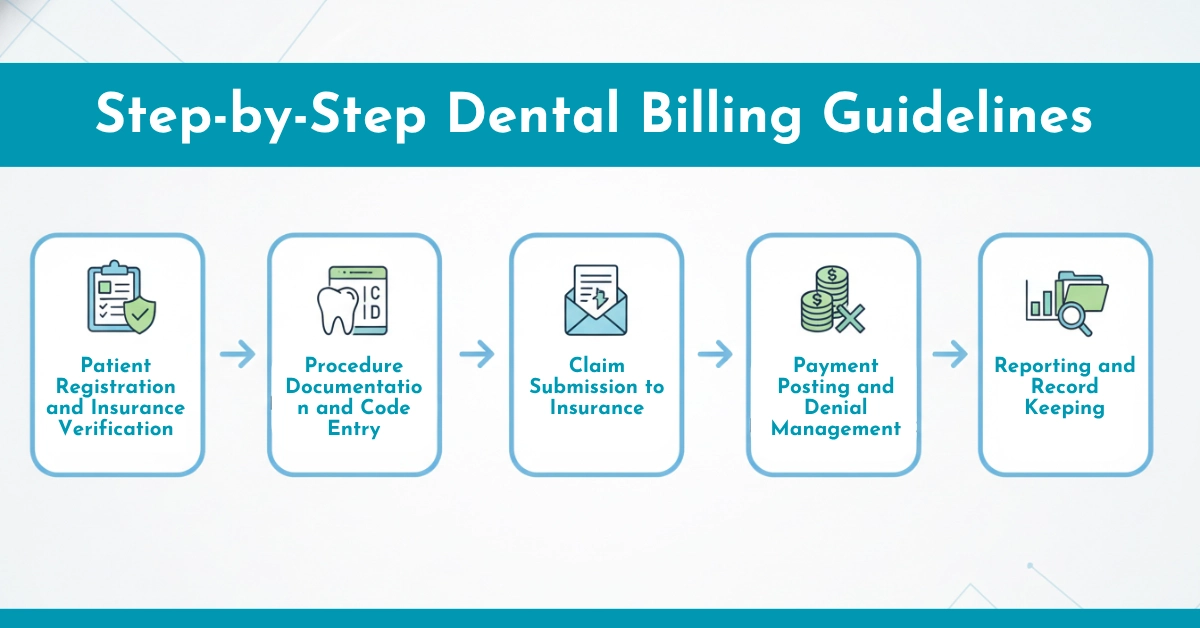Home / Dental Billing Process
In today’s healthcare landscape, the dental billing process is not just a side function for labs, clinics or hospitals. It’s a critical revenue-cycle element that keeps practices financially healthy and compliant. The dental billing process is the backbone of every successful dental practice. The alignment of accurate documentation, timely submissions, and correct coding via the ADA (American Dental Association) and CDT (Current Dental Terminology) code set ensures both reimbursement and regulatory adherence.
In this updated guide, you’ll learn about the latest CDT codes, simple cheat sheets, and how Hello MDs—a trusted medical billing partner—helps streamline your dental or mixed-practice revenue cycle.
Ever wondered what CDT coding is? It’s the backbone of dental billing, standing for Current Dental Terminology, a set of codes maintained by the ADA for standardizing procedures.
CDT dental meaning boils down to a universal language for insurers. Unlike medical codes, these are dental-specific, ensuring clear communication.
| Aspect | CDT Codes (Current Dental Terminology) | CPT Codes (Current Procedural Terminology) |
|---|---|---|
| Purpose | Used specifically for dental billing and reporting dental procedures. | Used for medical billing, including dental-related medical treatments. |
| Code Format | Always start with the letter “D” (e.g., D1110). | Five-digit numeric format (e.g., 41899). |
| Maintained By | Updated and published by the American Dental Association (ADA). | Updated and maintained by the American Medical Association (AMA). |
| Scope of Use | Covers preventive, restorative, surgical, and orthodontic dental services. | Covers general medical, surgical, and diagnostic procedures. |
| Claim Type | Submitted to dental insurance providers. | Submitted to medical insurance carriers. |
| Example | D7210 – Surgical removal of an erupted tooth requiring bone removal. | 41899 – Unlisted procedure, dentoalveolar structures. |
For dental to medical billing conversion, know the differences between CDT to CPT/ICD to avoid mix-ups.
Need a quick reference? A CDT codes and descriptions PDF or dental coding reference sheet is your go-to dental billing cheat sheet.
Codes start with ‘D’ followed by four digits, grouped by category (e.g., D0000-D0999 diagnostics).
Here is the 5-step follow-up plan followed by a dental insurance biller to process the medical dental billing.
Here’s where ADA dental coding shines.
Tip: Batch submissions weekly to keep cash flowing
Tip: Denial management is crucial; missing codes cause 40% of claim denials.

The ADA CDT code book 2025 brings 10 new codes, 8 revisions, 2 deletions, and 4 editorial tweaks. New ones include implant maintenance (D6089) and neuromodulator injections (D9997) for pain relief. Revisions clarify interim restorations like D2941. These dental coding updates 2025 address emerging techniques, per ADA announcements. Access the book via ADA.org for full details.
Let’s spotlight the common dental codes and the most common dental codes for 2025.
For billing implant bridge codes, use D6010 for placement, D6058 for abutment-supported crown.
Sometimes, dentistry goes medical. Dental to medical billing conversion uses a dental billing code crosswalk (CDT to CPT/ICD).
HelloMDs’ billing services assist with such conversions to ensure compliance and timely reimbursements.
Modern billing software can cross-check procedure codes automatically, alerting staff if a code or modifier is missing.

The dental billing process hinges on accurate CDT code sheet use and ADA dental coding. Embrace dental billing guidelines to minimize errors. Download a CDT codes and descriptions PDF for quick reference.
For practices, partnering with experts like HelloMDs in RCM healthcare services can handle denial management and account receivable, freeing you up.
Disclaimer:
This content is meant to share general information and isn’t a replacement for professional guidance. Always verify CDT, CPT, and ICD codes with insurers and regulatory guidelines before billing. Some images in this blog are created with AI and are meant for illustration purposes only.
The code for dental cleaning is D1110. Check frequency limitations per patient plan and document patient age, risk factors, and performed services
The ADA’s Code Maintenance Committee meets annually; the next “major” update (CDT 2026) will include ~60 changes and go into effect Jan 1, 2026
CDT codes are dental-specific, used for procedures like fillings, extractions, and cleanings. CPT codes are for medical procedures and are used when dental services have a medical component.
Yes, for qualifying cases such as oral/facial trauma, biopsies, or TMJ treatment. This requires a dental-to-medical billing conversion using CDT → CPT/ICD crosswalks to ensure proper reimbursement.
Dental billing uses CDT codes and focuses on dental-specific procedures, while medical billing uses ICD and CPT codes, covering broader healthcare services and insurance structures.